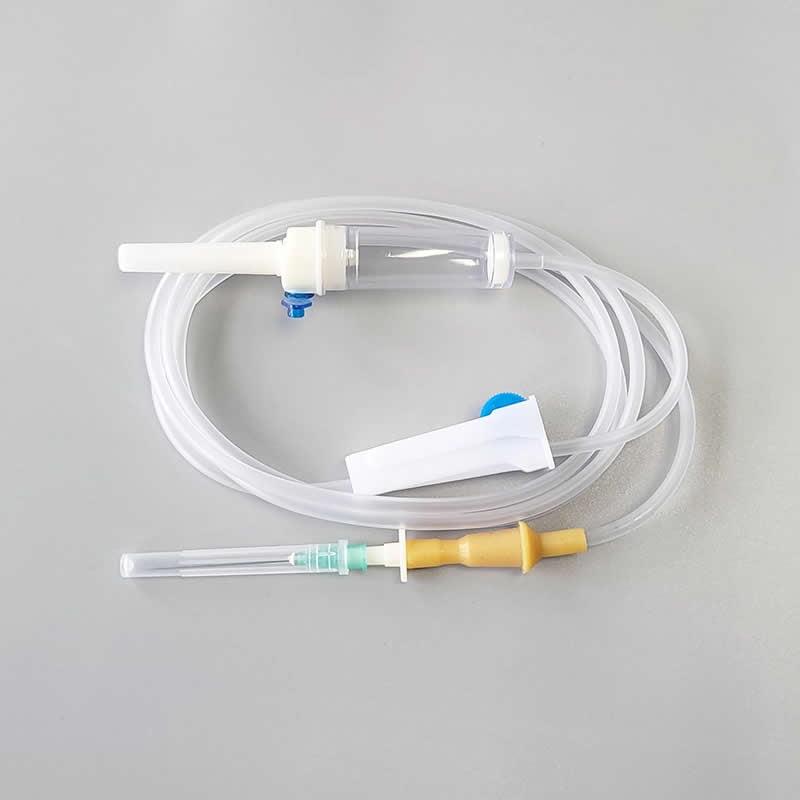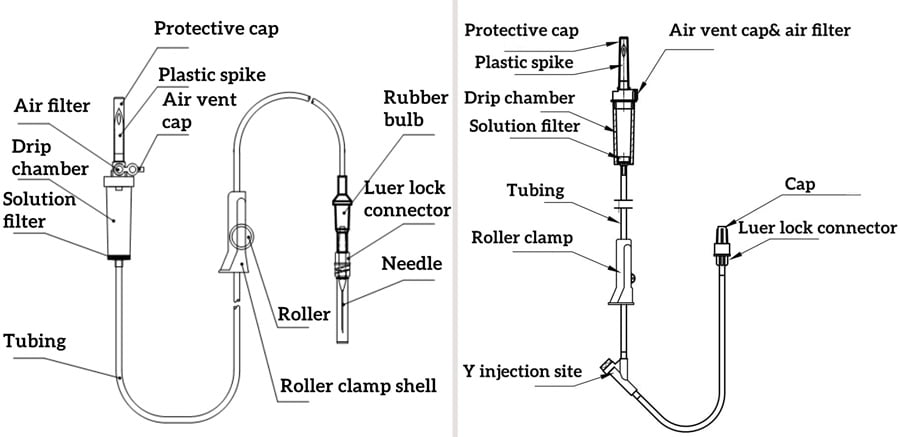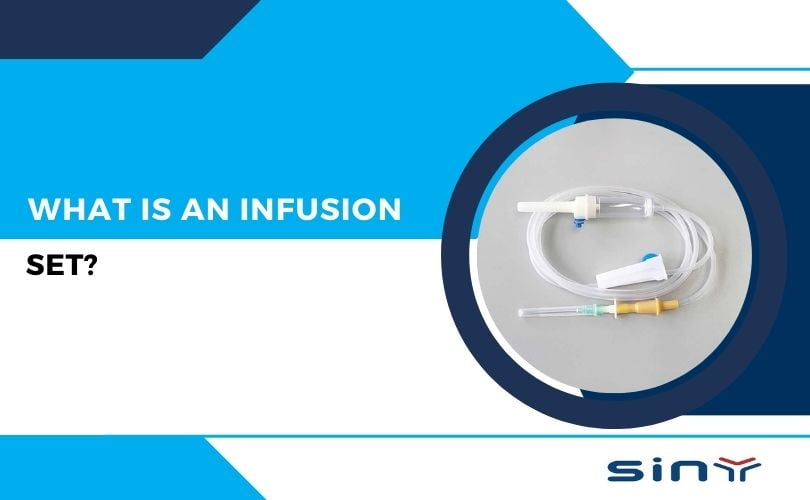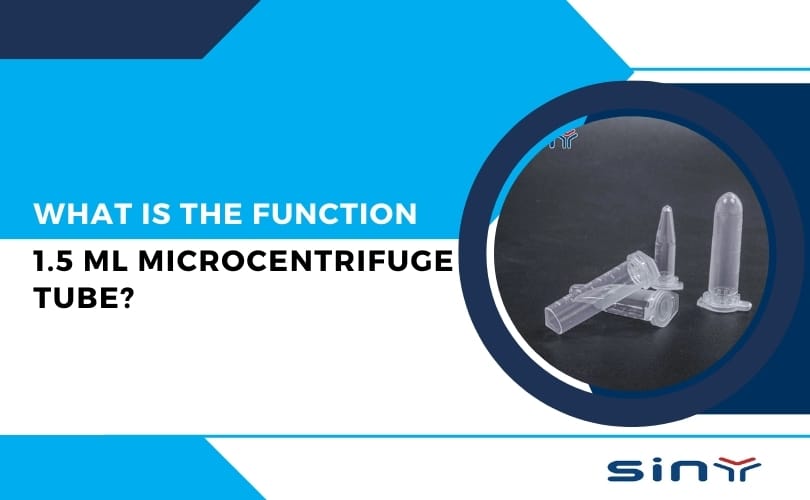An infusion set is a widely used medical device essential for administering intravenous (IV) fluids, medications, nutrients, or electrolyte solutions into the bloodstream. This system plays a pivotal role in medical treatments requiring continuous or controlled fluid delivery directly into a patient’s veins. Infusion sets are integral in hospitals, clinics, and even home care, especially for patients undergoing chemotherapy, fluid replacement, or insulin therapy for diabetes.
An infusion set comprises various interconnected parts designed to ensure fluid safe and effective delivery into the patient’s blood stream. These parts include an infusion tube, drip pot (drip chamber), flow regulator, and needle, each working harmoniously to facilitate a seamless infusion process. The device’s simplicity and efficiency have made it the most common choice for IV therapies, where precise control and consistent delivery of fluids are paramount.
Table of Contents
What is an Infusion Set?
An infusion set is a standard medical device mainly used to establish an intravenous channel to infuse drugs, nutrient solutions, and electrolyte solutions into the patient’s body.
An infusion set is a medical device used to infuse or inject medications. It usually consists of a flexible tube, a syringe or needle, and a connector.

The primary function of the infusion set is to deliver drugs into the patient’s body. It connects to an infusion bag or syringe and delivers medication through tubing into the patient’s blood vessels or subcutaneous tissue.
The main components of an infusion set
Infusion tube
It is generally made of plastic material and has a certain degree of flexibility and durability.
It is divided into an inlet tube and an outlet tube. The inlet tube is connected to the infusion bottle or bag, and the outlet tube is connected to the needle and inserted into the patient’s vein.
Drip pot
It is usually a transparent plastic container in the middle of the infusion tube.
Its function is to observe the drip rate of the infusion and prevent air from entering the infusion tube. When the liquid flows from the inlet tube into the drip pot, it will form a drop-by-drop state, which is convenient for medical staff to adjust the infusion speed.
Flow regulator
It is usually a roller device that can slide along the infusion tube.
The liquid’s flow rate is controlled by adjusting the degree of pressure of the roller on the infusion tube.
Needle
It is divided into scalp needles and indwelling needles.
Healthcare professionals usually use scalp needles for one-time infusions, while they retain indwelling needles in the patient’s body for some time, reducing the pain from multiple punctures.
Working principle of infusion set
The infusion set uses gravity to make the liquid in the infusion bottle, or infusion bag flow into the patient’s vein through the infusion tube. In this process, the drip pot can observe the infusion speed, and the flow regulator can adjust the infusion speed according to the patient’s condition and needs. At the same time, the infusion set also needs to ensure the sterility and safety of the liquid to avoid infection and other adverse reactions.

Precautions for use
- Strictly adhere to the principle of aseptic operation and check whether the infusion set’s packaging is intact and expired before use.
- Correctly select the infusion set’s model and specifications according to the patient’s age, condition, and the nature of the infusion drug.
- Adjust the infusion speed slowly to avoid adverse reactions caused by too fast or too slow.
- Pay attention to the patient’s reaction. If you notice allergies, pain, swelling, or other abnormal conditions, stop the infusion immediately and notify the medical staff.
- After the infusion, the set should be handled appropriately to avoid polluting the environment.
What types of infusion sets are there?
There are mainly the following types of infusion sets
Gravity Infusion Set
- Description: This type of infusion set is the most common. It relies on gravity to deliver fluids. You hang the infusion bag or bottle at a height, which allows the liquid to flow through the tubing into the patient.
- Advantages: Simple operation, low cost.
- Disadvantages: The height difference and the viscosity of the liquid affect the infusion speed, making it difficult to control accurately.
Pressure Infusion Set
- Description: utilizes external pressure sources, such as infusion pumps, to deliver fluids at a controlled pressure.
- Advantages: Allows for precise control of infusion speed and volume, making it suitable for critically ill patients or infants.
- Disadvantages: higher equipment costs and more complex operation compared to gravity sets.
Ordinary Infusion Set
- Description: A basic infusion set without specialized filtering devices, suitable for general use.
- Advantages: Cost-effective for standard infusion needs.
- Disadvantages: Only filters larger particles; not suitable for patients with high infusion requirements.
Precision Filtration Infusion Set
- Description: Equipped with a precision filter to remove smaller particles, including bacteria and insoluble particles.
- Advantages: Reduces the risk of adverse reactions, making it ideal for vulnerable populations such as children, the elderly, and critically ill patients.
- Disadvantages: Generally more expensive due to the added filtration technology.
Light-Shielding Infusion Set
- Description: Designed for light-sensitive medications, featuring tubing made from light-blocking materials.
- Advantages: Prevents drug decomposition or deterioration due to light exposure.
- Disadvantages: Limited to specific medications that require protection from light.
Micro-Infusion Set
- Description: Used for the precise administration of small volumes of medication, such as insulin or anesthetics.
- Advantages: Offers accurate flow control with a smaller drop coefficient.
- Disadvantages: Typically more complex and requires careful monitoring.
Nutrient Infusion Set
- Description: Specifically designed for the infusion of nutrient solutions, such as fat emulsions or amino acids.
- Advantages: Adapted to handle the unique properties of nutrient solutions, including high viscosity.
- Disadvantages: May not be suitable for general fluid administration.
How to use the infusion set?
Preparation
- Hand Washing:
- Medical staff should wash their hands thoroughly to maintain cleanliness and prevent cross-contamination.
- Check the Infusion Set:
- Inspect the packaging of the infusion set for integrity, expiration, and any damage. Ensure all components are present, including the infusion tube, drip chamber, flow regulator, and needle.
- Prepare Drugs:
- Gather the prescribed medications for infusion. Verify the name, dosage, concentration, expiration date, and ensure the packaging is intact without any damage or leakage.
Operation Steps
- Insert the Infusion Tube:
- Connect the infusion tube to the infusion bottle or bag by inserting the plug securely into the opening.
- Exhaust Air:
- Hang the infusion tube upside down, open the flow regulator, and allow the liquid to flow into the drip chamber until it is about half full. Then, gently squeeze the drip chamber to expel any air from the infusion tube until liquid flows out of the needle.
- Select the Puncture Site:
- Choose an appropriate site for venipuncture, typically on the back of the hand or forearm, based on the patient’s condition.
- Disinfect the Puncture Site:
- Clean the selected site with iodine or alcohol swabs, ensuring the disinfection area is at least 5 cm in diameter.
- Puncture:
- Hold the needle with your dominant hand, stretch the skin taut with the other hand, and insert the needle into the vein at a suitable angle. Once blood returns in the catheter, advance the needle slightly.
- Fix the Needle:
- Secure the needle in place using adhesive tape or an infusion patch to prevent movement.
- Adjust the Infusion Speed:
- Set the infusion speed according to the patient’s needs and doctor’s instructions. Adjust the infusion rate to 40 to 60 drops per minute for adults, and slow it down for children and the elderly.
- Observe the Patient’s Reaction:
- Monitor the patient for any adverse reactions such as allergies, pain, or swelling. Keep an eye on the drip rate and total infusion volume, addressing any issues promptly.
End the Infusion
- Turn Off the Flow Regulator:
- When the infusion is nearing completion, turn off the flow regulator to stop the infusion.
- Remove the Needle:
- Press the puncture site with a dry cotton swab or cotton ball, quickly withdraw the needle, and instruct the patient to apply pressure to the site for 5 to 10 minutes to prevent bleeding.
- Disposal of Infusion Sets:
- Dispose of the used infusion set according to medical waste disposal regulations to prevent environmental contamination.
Conclusion
Infusion sets are indispensable tools in modern medicine, offering a reliable way to deliver fluids and medications directly into the bloodstream. By understanding the various components, types, and proper usage of infusion sets, healthcare providers can enhance patient care, ensuring that treatments are both safe and effective.
FAQs
What types of infusion sets are available?
Common types include gravity infusion sets, pressure infusion sets, ordinary infusion sets, precision filtration infusion sets, light-shielding infusion sets, micro-infusion sets, and nutrient infusion sets.
How does a gravity infusion set work?
A gravity infusion set relies on the force of gravity to allow fluids to flow from a hanging infusion bag or bottle through the tubing into the patient’s vein.
What are the advantages of using a pressure infusion set?
The micro-infusion set precisely administers small volumes of medication, such as insulin or anesthetics.
How do you prepare an infusion set for use?
Preparation involves washing hands, checking the IV infusion set for damage or expiration, and preparing the medication according to the doctor’s instructions.
What is a micro-infusion set used for?
The micro-infusion set precisely administers small volumes of medication, such as insulin or anesthetics.
Can infusion sets be reused?
Manufacturers of siny medical IV infusion sets or typically design infusion sets for single use to maintain sterility and prevent infections.



























































